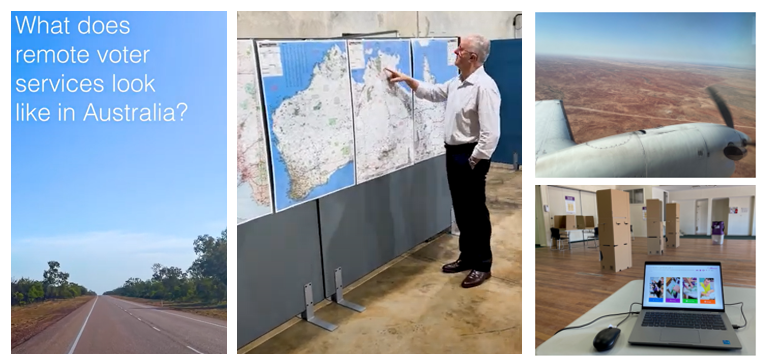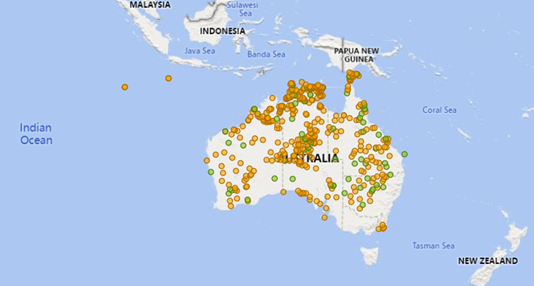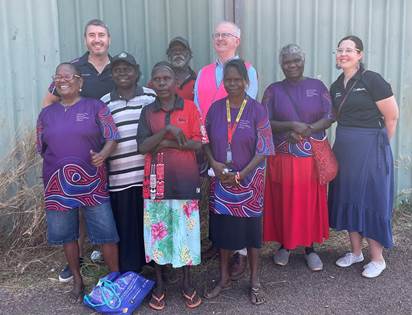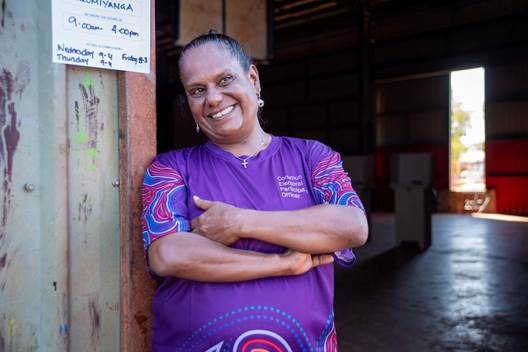Australian Electoral Commission



From Darwin airport in a seven-seat plane to an airstrip on Bathurst Island off the northern coast of Australia where a mini-bus awaits, to the community’s basketball court where there is the distinctive look of cardboard voting screens and the AEC’s purple vests.
Wurrumiyanga is one of many communities in the Northern Territory, and right across remote areas of Australia, where some of the first votes in the 2023 referendum have been cast – an activity that began on Monday and will continue for three weeks leading up to 14 October.

AEC TV videos:
The AEC’s remote operations centre
Remote voter services for the 2023 referendum
More than 60 teams of 3-4 polling officials each are loading their 4WDs, helicopters, planes and - in some cases in the Torres Strait - helicopters and ferries to bring democracy to some of Australia’s smallest communities.
Electoral Commissioner Tom Rogers was in Wurrumiyanga on Tuesday and said that no matter how you vote, the remote voting service is a hallmark of Australian elections to be proud of.
“Australia’s electoral events are unique - the geography is huge and the effort our teams go to in order to provide people with an in-person service is world-leading,” Mr Rogers said.
“The AEC’s distinct purple vest is out and about across this vast geography we all call home and they’re delivering democracy - it is fabulous to see it in full flight again and bigger than it has ever been.”

Image: A map of locations for AEC remote service delivery and training activities
“Providing voting services in remote areas is incredibly complex - scheduling and logistical arrangements require us to be agile as we cover thousands of square kilometres but it’s a privilege to deliver such a service.”
“There are individual charter flights that cover hundreds of kilometres and teams traversing unsealed terrain with polling setup in halls, gazebos and sometimes the shade of a nice tree.”
“I hear all the time about reasonably extreme individual circumstances - if people are out at sea, on an oil rig or climbing a mountain we sometimes just can’t facilitate that, but what we do accomplish is pretty extraordinary.”
Electoral Commissioner Tom Rogers said it is not just the polling activities themselves that are underway but a significant communication campaign as well.
“The schedule is incredibly challenging and complex of course but significant effort goes into letting people in remote communities know when we’ll be there,” Mr Rogers said.
“We’ve liaised with local communities when planning the service, the schedule is on the website, posters are distributed into communities, we have advertising, we engage with community radio, our teams have continued to visit communities ahead of polling to discuss the service, we’re sending SMS messages where we have the details, and we hire local assistants in community.”
“We’re not just on community notice boards and engaging in-person. Our notices are on TV – including Aboriginal Health TV, on radio in more than 20 First Nations languages, on digital display and social media targeted to relevant postcodes, in community newspapers and via search advertising.”
“This has been underway for some time as well, with more than 140 referendum education sessions run in remote communities around Australia and partnerships with local Indigenous organisations to educate community members about the process.”
“There is no doubt that many of these communities are hard to reach - both physically and with forms of community announcements - but we invest hugely in this service offering and in communicating about the service as well.”
“We’re thankful to local community members, broadcasters and others who are assisting in this process – it can never just be the electoral management body alone that gets the message through about voting services available.”
“Just one example of people assisting to get the word out is the Community Broadcasting Association of Australia’s member newsletter, which reaches 95% of community radio stations in Australia, and has carried information about schedules and a reminder to broadcast.”
“Many people are helping to spread the word as much as possible and we’d encourage people to continue to do so.”
“In particular we’re thankful to local assistants in remote mobile polling locations that we’ve engaged - many of these people who we employ temporarily are bi-lingual and help not just to advise their community about the service available but also help educate residents in their own communities about the voting process.”

Image: Electoral Commissioner Tom Rogers, members of the AEC’s Indigenous Electoral Participation Program, AEC Community Engagement Officers and members of the Wurrumiyanga community on 26 September 2023.

Image: AEC Indigenous Electoral Participation Program staff member Mavis Kerinaiua in the Wurrumiyanga community on 26 September 2023. Courtesy of ABC.
“We have more than 60 Community Engagement Participation Officers who are critical and add to our 50 plus members of the Indigenous Electoral Participation Program – all these people are in communities now helping people to access and understand the service.”
“In addition to local assistants, we have in-language information available about the referendum process on iPads that our mobile teams use to assist members of local communities.”
*Early voting centres in urban areas and regional towns will open from Monday 2 October (or Tuesday 3 October for states/territories with a public holiday). Early voting centre locations and referendum day polling places are now also available on the AEC’s referendum website.